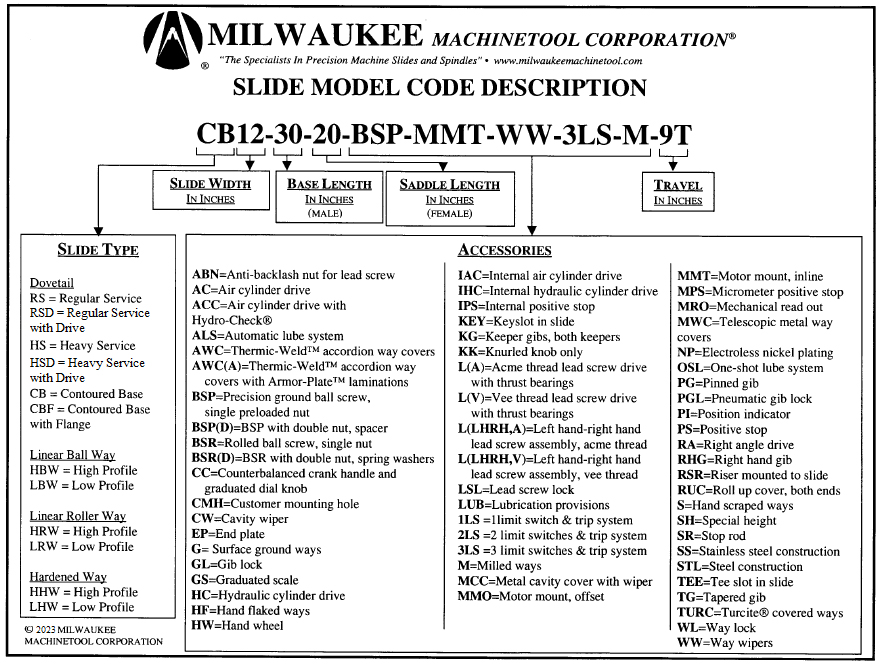Machine Slide Selection
The following factors will decide the type of machine slide and its size for a particular application. In many cases, more than one slide will meet the application’s technical requirements. Contact MILWAUKEE to ensure the most appropriate slide is chosen.
Accuracy and Precision
How straight must the slide track? How flat do the mounting surfaces need to be? Under what kind of loading and vibration must the accuracy be maintained?
- Rigidity
- The rigidity of a slide is not easily predicted. Generally, the higher the cross-section of a slide, the greater the rigidity
- Operational clearance
- Sliding friction-type slides (dovetail, hardened way) must have clearance between the sliding members to move; this clearance allows pitch, roll and yaw movements, which reduce the accuracy of the slide
- The linear guide type of slide (ball or roller) has zero operational clearance. This is because the linear guides employ rolling elements that are preloaded, thus eliminating all clearance and associated movement
- Way Finish (Dovetail type slides)
- For dovetail slides, way finish may be supplied as precision milled or may also be precision surface ground. Precision surface ground slides are of a greater accuracy than slides with milled way surfaces
Loading
Slides must be sized to handle the applied loads and vibration imparted. For metal cutting applications, slides must not only handle the cutting forces, but also must also transmit and absorb vibration. Contact MILWAUKEE for sizing
- Dovetail slides have the lowest load capacity for their size
- Turcite ® low friction bearing material applied to the slide’s way surfaces adds to the slide’s load capacity
- Hardened way slides have Turcite ® saddle way surfaces as standard, and have higher load capacities
- Linear guide slides with rollers have the highest load capacities
- Usually the loading of the slide is not the main criteria for metal cutting applications – rigidity and accuracy are
Duty Cycle
How often will the slide be used? What kind of reliability is required?
- For high-cycle applications (such as high-volume production applications), hardened way or linear guide slides are recommended
- For manual positioned applications, dovetail slides generally are the first choice
Budget
- Dovetail slides are the least expensive
- Hardened way and linear guide slides are comparable in price and are the most expensive
Size of mounting surface and travel
How long and wide must the mounting surface of the slide be? How much stroke is required?
- Generally, the length of the saddle must be equal to or greater than the slide width
- If a large mounting surface is required but the optimal slide size is smaller, a steel riser plate can mounted to the slide to provide the required mounting dimensions. This is more economical than increasing the size of slide
Types of MILWAUKEE Machine Slides
Dovetail Slides
Dovetail slides are rugged positioning units that are suited for manual or powered movement
- Typically applications: positioning, light machining
- Duty: Where occasional movement or low duty cycles are required
- Low to moderate loading
- Nominal accuracy requirements
- A sliding friction type of slide, with operational running clearance
Hardened Way Slides
Hardened way slides are designed for production use, where high usage and heavy loads are expected. These slides are designed for years of use with minimal maintenance
- Typical applications: feeding of spindles for production machining
- Duty: Rated for continuous duty
- Moderate to high loading
- High accuracy requirements
- A sliding friction type of slide, with operational running clearance
Linear Guide Slides
Linear guide slides are the most modern design of slide. These slides have the highest load capacities for their size of any slide. In addition, they have the lowest friction, permitting smaller drive systems
- Typical applications: feeding of spindles for production machining or precision positioning
- Duty: Rated for continuous duty
- Moderate to high loading
- Highest accuracy requirements
- A rolling element type of slide, with zero running clearance

